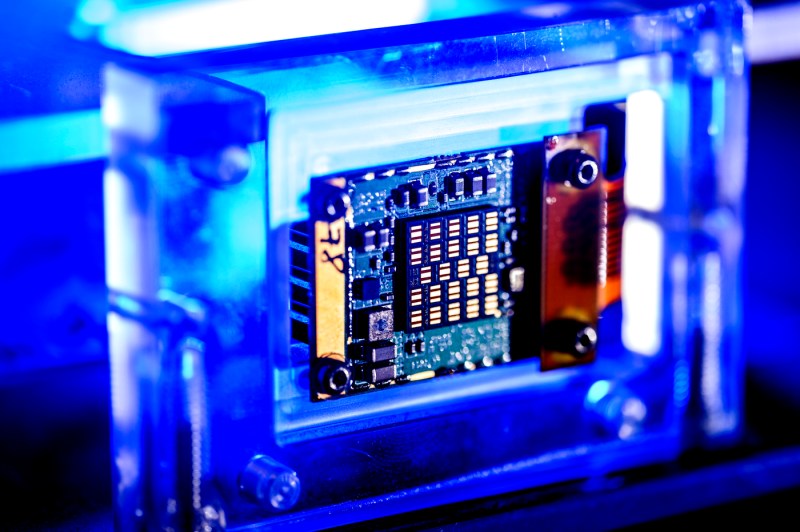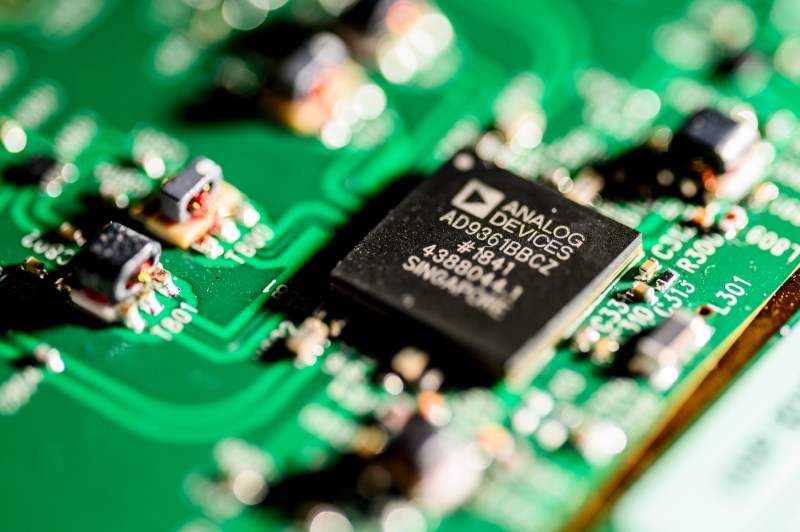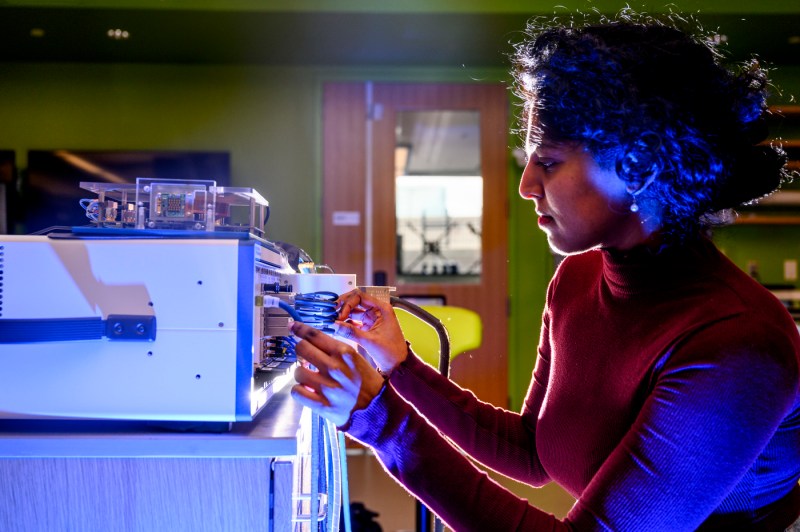Published on
The next generation of wireless communication is being built at Northeastern and this researcher is leading the charge
Having joined the university in 2014 as an electrical and computer engineering professor, Tommaso Melodia has helped transform Northeastern into one of the premier centers for wireless communications research.

Tommaso Melodia got his first glimpse of the power of the internet as a high schooler growing up in Italy in the early 1990s.
The technology at the time would be considered rudimentary, crude and basic by today’s standards, but was transformative in helping connect thousands of people surfing online for the first time.
Dial-up-powered computer bulletin board systems (BBS) were popular ways to connect. What was needed was a now-clunky personal computer, a network modem and a phone number to dial in to a BBS server.
“You would basically pick up the phone, dial a number and then you would connect to an information system,” he says. “It had chats, large groups where you could discuss things. You could download files. You could download programs.”
A spark that started it all
That was about a decade before the modern world wide web would explode onto the scene and change the world forever. But even then, Melodia was fascinated with the power that technology could have in connecting humans.
“I wanted to develop better communication systems and learn everything possible,” he says. “I was obsessed with knowing everything, any little detail how you could develop new protocols on the internet.”
It’s that obsession that led Melodia down a path that would see him helm the Institute for the Wireless Internet of Things at Northeastern University — one of the world’s most prestigious research centers focused on the evolution of wireless mobile network technologies like 5G and 6G.



“Connectivity is something that impacts 100% of the economy,” Melodia said during a recent visit to his lab at the university’s campus in Burlington, Massachusetts — home to the world’s most powerful wireless emulator, Colosseum. “It impacts health. It impacts security, pretty much every aspect of the human experience. That’s what excites and motivates me.”
Having joined the university in 2014 as an electrical and computer engineering professor, Melodia has spent the last nine years with a mandate to grow Northeastern into one of the premier centers for wireless communications research. During that time, he has helped spearhead initiatives related to interoperable mobile networks, wireless 6G technologies, medical implants, underwater communications systems and more.
“My impression when I interviewed with Northeastern was that it was a place that was growing,” he says. “You could really have an impact, and frankly that’s what I think has happened.”



Four years after joining the university, Melodia was named the William Lincoln Smith Professor, in honor of William Lincoln Smith who served as the first chair of Northeastern’s electrical engineering department in 1937.
Melodia was bestowed the honor in recognition of his various contributions as a researcher evaluating, optimizing, and modeling wireless communication systems and wireless internet of things technologies. That same year, he was named director of the university’s new Institute for the Wireless Internet of Things, which is working to advance a whole range of connected technologies — from unmanned aerial vehicles to cellular technologies.
“We have a mission related to research — we want to be a leading institution in the area of smart and connected devices,” he says. “We have an educational mission — we want to train the next generation of researchers and professionals with interdisciplinary skills in this area with hands-on skills.”
One area of particular focus has been on the development of open radio access network technologies, a new form of technology focused on creating mobile networks that are more interoperable and less fragmented and expensive to operate. The institute recently received $8 million in federal funding for open RAN related projects.
“Open RAN will enable cellular networks that are open, programmable, and based on software. This means that operators will be able to fine tune their network and improve the reactiveness, the data rates (how fast you can transmit data), and the overall quality of the service provided to regular customers,” Melodia says.
A deeper look at the Institute of Wireless IoT
The institute is spread out between the Boston and Burlington campuses. Melodia’s office on the fourth floor of the Interdisciplinary Science and Engineering Complex in Boston overlooks the pedestrian bridge and is in clear view of the new EXP research complex.
The Institute for the Wireless Internet of Things is located in EXP.
Melodia splits his time between the two locations, starting off most of his weeks in Burlington at the center’s 4,500-square-foot research center.
Melodia’s Mondays usually start with weekly operations meetings to discuss the latest developments regarding Colosseum. He then usually takes a stroll to Byron K Elliot Hall to visit the two startups that were spun out of his lab — Bionet Sonar and HydroNet.
He’s working on bringing their emerging technologies to market.
Bionet is a medical internet of things company and develops dime-sized smart medical implants that use proprietary ultrasonic technology to replace traditional pacemakers and other medical implants that rely on microwave technologies. The older devices are bulky, consume large amounts of data and don’t communicate as well throughout the body.
“We’ve been developing a couple of different technologies,” Melodia says. One highlight is a neurostimulator device that is going through testing. It is designed to be implanted in the brain to replace larger neural simulators used to treat neurological conditions.
“Once commercialized and more advanced, it could be used for Parkinson as well as for epilepsy,” he says.
Featured Posts
HydroNet develops underwater communication systems. Underwater environments are difficult to create communication systems for because technologies like Wi-Fi and Bluetooth don’t work in those environments, Melodia explains. Hydronet is working to develop some of the bedrock technologies needed for underwater autonomous vehicles to operate and to help the defense and aquaculture industries conduct operations in the deep sea.
Researchers out of the Institute for The Wireless Internet of Things Lab make up some of the staff of both companies, and many are former students, including Kerem Enhos, a senior researcher at Hydronet.
He graduated from Northeastern in 2023 with a doctorate in electrical and electronics engineering, and has had the perspective of working with Melodia both as a student and an employee.
“His passion for research and innovation inspired me to pursue excellence in my work,” Enhos says. “And his genuine commitment to the success of his students fostered a collaborative and nurturing environment within our research group.
“Since transitioning to Hydronet, I’ve had the privilege of continuing to work closely with Tommaso in a different capacity. His leadership style, characterized by a blend of vision, expertise and empathy creates an environment where every team member feels valued and empowered to contribute their best.”
Enhos adds that Melodia’s insights into underwater acoustics, wireless communication and sharp business acumen have been essential for Hydronet’s growth, and moreover, the industry.
“We leverage his profound knowledge and experience in multiple ways to enhance our product testing and development processes,” Enhos says. “His insights help us identify emerging trends, anticipate market demands, and innovate our solutions to meet the evolving needs of our customers,” he says.
Cesareo Contreras is a Northeastern Global News reporter. Email him at c.contreras@northeastern.edu. Follow him on X/Twitter @cesareo_r and Threads @cesareor.










